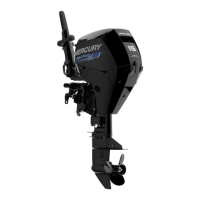BATTERY CHARGING AND STARTING SYSTEMS
90-826883R2 JUNE 1998 Page 2B-9
Battery Charging System
Troubleshooting
A fault in the battery charging system usually will cause the battery to become under-
charged. Check battery electrolyte level, and charge battery. See “Electrolyte Level”,
and “Charging a Discharged Battery”.
If battery will NOT accept a satisfactory charge, replace battery.
Ifbatteryacceptsasatisfactorycharge,determinethecauseofthechargingsystemprob-
lem as follows.
1. Checkfor correctbatterypolarity [REDcableto POSITIVE(+) batteryterminal]. Ifpo-
larity was incorrect, check for damaged rectifier. See “RECTIFIER TEST”.
2. Check for loose or corroded battery connections.
3. Visuallyinspectwiringbetweenstatorandbatteryforcuts,chafing;anddisconnected,
loose or corroded connection.
4. Excessiveelectrical load(fromtoo manyaccessories)willcause battery to rundown.
If visual inspection determines that battery connections and wiring are OK, perform the
following stator and rectifier tests.
Alternator Test
*NOTE: Alternator can be tested without removing from engine. DC resistance of these
windings generally is less than 1 ohm. A reading that resembles a short is acceptable.
1. Disconnect GRAY and YELLOW alternator leads from terminals on either rectifier,
voltage regulator or isolator block.
2. Use an ohmmeter and perform tests as shown in following chart.
3. If meter readings are other than specified, replace alternator assembly.
Test Leads Resistance Scale
RED to YELLOW
BLACK to GRAY
0.65 R x 1
RED to either GRAY or YELLOW
BLACK to GROUND NO CONTINUITY R x 1000

